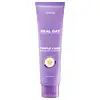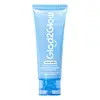What's inside
What's inside
 Key Ingredients
Key Ingredients

 Benefits
Benefits

 Concerns
Concerns

No concerns
 Ingredients Side-by-side
Ingredients Side-by-side

Water
Skin ConditioningCocamidopropyl Betaine
CleansingGlycerin
HumectantAvena Sativa Kernel Meal
AbrasivePEG-150 Distearate
EmulsifyingSodium Lauroyl Methylaminopropionate
CleansingAcrylates Copolymer
Potassium Cocoyl Glycinate
Sodium Benzoate
MaskingAllantoin
Skin ConditioningPotassium Cocoate
EmulsifyingCitric Acid
BufferingPanthenol
Skin ConditioningPhenoxyethanol
PreservativeButylene Glycol
HumectantPotassium Hydroxide
BufferingEthylhexylglycerin
Skin ConditioningChamomilla Recutita Extract
Skin ConditioningPropylene Glycol
HumectantCeteareth-25
CleansingLaminaria Digitata Extract
Skin Protecting1,2-Hexanediol
Skin ConditioningCetyl Alcohol
EmollientHydrogenated Lecithin
EmulsifyingCholesterol
EmollientCeramide NP
Skin ConditioningBehenic Acid
CleansingCeramide Ns
Skin ConditioningCeramide EOP
Skin ConditioningCeramide AP
Skin ConditioningCeramide Eos
Skin ConditioningCetyl-Pg Hydroxyethyl Palmitamide
Skin ConditioningCeramide As
Skin ConditioningCaprooyl Phytosphingosine
Skin ConditioningCaprooyl Sphingosine
Skin ConditioningWater, Cocamidopropyl Betaine, Glycerin, Avena Sativa Kernel Meal, PEG-150 Distearate, Sodium Lauroyl Methylaminopropionate, Acrylates Copolymer, Potassium Cocoyl Glycinate, Sodium Benzoate, Allantoin, Potassium Cocoate, Citric Acid, Panthenol, Phenoxyethanol, Butylene Glycol, Potassium Hydroxide, Ethylhexylglycerin, Chamomilla Recutita Extract, Propylene Glycol, Ceteareth-25, Laminaria Digitata Extract, 1,2-Hexanediol, Cetyl Alcohol, Hydrogenated Lecithin, Cholesterol, Ceramide NP, Behenic Acid, Ceramide Ns, Ceramide EOP, Ceramide AP, Ceramide Eos, Cetyl-Pg Hydroxyethyl Palmitamide, Ceramide As, Caprooyl Phytosphingosine, Caprooyl Sphingosine
Water
Skin ConditioningGlycerin
HumectantAcrylates Copolymer
Sodium Cocoyl Alaninate
Panthenol
Skin ConditioningHydroxyacetophenone
Antioxidant1,2-Hexanediol
Skin ConditioningPotassium Hydroxide
BufferingCentella Asiatica Leaf Extract
Skin ConditioningAllantoin
Skin ConditioningTremella Fuciformis Sporocarp Extract
AntioxidantSodium Hyaluronate
HumectantCetyl Alcohol
EmollientMaltooligosyl Glucoside
Skin ConditioningCitrus Paradisi Peel Oil
MaskingCitrus Aurantium Bergamia Fruit Oil
MaskingStyrene/Acrylates Copolymer
Water, Glycerin, Acrylates Copolymer, Sodium Cocoyl Alaninate, Panthenol, Hydroxyacetophenone, 1,2-Hexanediol, Potassium Hydroxide, Centella Asiatica Leaf Extract, Allantoin, Tremella Fuciformis Sporocarp Extract, Sodium Hyaluronate, Cetyl Alcohol, Maltooligosyl Glucoside, Citrus Paradisi Peel Oil, Citrus Aurantium Bergamia Fruit Oil, Styrene/Acrylates Copolymer
 Reviews
Reviews

Ingredients Explained
These ingredients are found in both products.
Ingredients higher up in an ingredient list are typically present in a larger amount.
1,2-Hexanediol is a synthetic liquid and another multi-functional powerhouse.
It is a:
- Humectant, drawing moisture into the skin
- Emollient, helping to soften skin
- Solvent, dispersing and stabilizing formulas
- Preservative booster, enhancing the antimicrobial activity of other preservatives
Acrylates Copolymer is used as a film-forming agent and texture enhancer.
After applied, Acrylates Copolymer forms a thin film cover that helps skin feel more soft. It can help sunscreens become more water-resistant.
It is also used to make a product more thick.
Learn more about Acrylates CopolymerAllantoin is a soothing ingredient known for its protective and moisturizingg properties. Because of this, it is often added to products with strong active ingredients.
Studies show higher concentrations of this ingredient can promote wound healing.
Though it can be derived from the comfrey plant, allantoin is produced synthetically for cosmetic products to ensure purity.
Learn more about AllantoinCetyl Alcohol is a fatty alcohol. Fatty Alcohols are most often used as an emollient or to thicken a product.
Its main roles are:
Though it has "alcohol" in the name, it is not related to denatured alcohol or ethyl alcohol.
The FDA allows products labeled "alcohol-free" to have fatty alcohols.
Learn more about Cetyl AlcoholGlycerin is already naturally found in your skin. It helps moisturize and protect your skin.
A study from 2016 found glycerin to be more effective as a humectant than AHAs and hyaluronic acid.
As a humectant, it helps the skin stay hydrated by pulling moisture to your skin. The low molecular weight of glycerin allows it to pull moisture into the deeper layers of your skin.
Hydrated skin improves your skin barrier; Your skin barrier helps protect against irritants and bacteria.
Glycerin has also been found to have antimicrobial and antiviral properties. Due to these properties, glycerin is often used in wound and burn treatments.
In cosmetics, glycerin is usually derived from plants such as soybean or palm. However, it can also be sourced from animals, such as tallow or animal fat.
This ingredient is organic, colorless, odorless, and non-toxic.
Glycerin is the name for this ingredient in American English. British English uses Glycerol/Glycerine.
Learn more about GlycerinPanthenol is a common ingredient that helps hydrate and soothe the skin. It is found naturally in our skin and hair.
There are two forms of panthenol: D and L.
D-panthenol is also known as dexpanthenol. Most cosmetics use dexpanthenol or a mixture of D and L-panthenol.
Panthenol is famous due to its ability to go deeper into the skin's layers. Using this ingredient has numerous pros (and no cons):
Like hyaluronic acid, panthenol is a humectant. Humectants are able to bind and hold large amounts of water to keep skin hydrated.
This ingredient works well for wound healing. It works by increasing tissue in the wound and helps close open wounds.
Once oxidized, panthenol converts to pantothenic acid. Panthothenic acid is found in all living cells.
This ingredient is also referred to as pro-vitamin B5.
Learn more about PanthenolPotassium hydroxide is commonly known as caustic potash. It is used to fix the pH of a product or as a cleaning agent in soap. In cleansers, it is used for the saponification of oils.
Sapnification is the process of creating fatty acid metal salts from triglycerides and a strong base. During this process, Potassium Hydroxide is used up and is not present in the final product.
Using high concentrations of Potassium Hydroxide have shown to irritate the skin.
Learn more about Potassium HydroxideWater. It's the most common cosmetic ingredient of all. You'll usually see it at the top of ingredient lists, meaning that it makes up the largest part of the product.
So why is it so popular? Water most often acts as a solvent - this means that it helps dissolve other ingredients into the formulation.
You'll also recognize water as that liquid we all need to stay alive. If you see this, drink a glass of water. Stay hydrated!
Learn more about Water